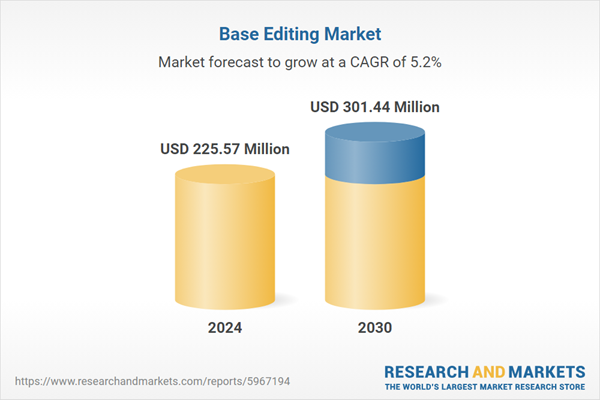Speak directly to the analyst to clarify any post sales queries you may have.
10% Free customizationThis report comes with 10% free customization, enabling you to add data that meets your specific business needs.
The market growth is primarily driven by increasing investments in gene therapy and precision medicine, where base editing holds promise for correcting genetic mutations responsible for a wide range of inherited disorders and diseases such as sickle cell anemia, muscular dystrophy, and various forms of cancer. The potential to enable targeted, single-base modifications with minimal off-target effects makes base editing a compelling tool for both research and therapeutic applications.
Key Market Drivers
Growth in Healthcare Industry
The robust growth of the healthcare industry is a fundamental driver accelerating the expansion of the global base editing market. The global healthcare industry generates annual sales exceeding USD 4 trillion. The most substantial and profitable segments are pharmaceuticals and biotechnology, approaching USD 850 billion, followed by medical technology and diagnostics, which surpass USD 400 billion. As healthcare systems worldwide evolve to meet rising patient demands and address complex genetic disorders, innovative gene-editing technologies such as base editing are gaining significant traction.Currently, rare disorders encompass approximately 7,500 distinct conditions affecting multiple systems. Diagnosing these diseases is challenging due to a shortage of specialized medical professionals, limited access to diagnostic laboratories, and constrained therapeutic options. The increasing prevalence of genetic diseases and the emphasis on precision medicine have intensified the need for advanced therapeutic solutions that offer greater accuracy and fewer off-target effects. Base editing, with its ability to precisely modify DNA at the single-base level, represents a transformative approach in genetic research and therapeutic development.
Key Market Challenges
High Technical Complexity
The global base editing market faces significant challenges stemming from the high technical complexity inherent in the technology. Base editing, while revolutionary in its ability to precisely modify DNA at the single-base level, requires sophisticated molecular tools and intricate delivery mechanisms that demand advanced expertise and rigorous optimization.One of the primary technical hurdles is ensuring the specificity and efficiency of base editors to minimize off-target effects, which can lead to unintended genetic alterations with potentially harmful consequences. Achieving this level of precision necessitates extensive research and development, as well as continual refinement of the enzymes and guide RNA components involved in the editing process.
Key Market Trends
Expansion of Base Editing Applications
The continuous expansion of base editing applications is a prominent trend shaping the trajectory of the global base editing market. Initially focused on correcting point mutations in genetic research, base editing technology is now being increasingly applied across diverse therapeutic areas, agricultural biotechnology, and industrial bioprocessing. Base editing is an innovative technique that enables precise, programmable nucleotide substitutions without disrupting the gene or requiring a donor template. Prime editing further advances this capability by improving genome editing efficiency and product accuracy compared to CRISPR/Cas9, and it has been rapidly adopted in plant and agricultural research.Advancements in base editing have broadened its utility beyond rare genetic disorders to more complex diseases such as cancer, cardiovascular conditions, and infectious diseases. This diversification is driven by ongoing research demonstrating the technology’s potential for precise, efficient, and safer gene modifications compared to traditional gene-editing methods.
Key Market Players
- Danaher Corporation
- Merck KGaA
- Revvity, Inc.
- Maravai LifeSciences
- GenScript Biotech
- Beam Therapeutics
- Intellia Therapeutics, Inc.
- Cellectis
- ElevateBio
- Bio Palette Co., Ltd
Report Scope
In this report, the Global Base Editing Market has been segmented into the following categories, in addition to the industry trends which have also been detailed below:Base Editing Market, By Products & Services:
- Platform
- Kits & Reagents
- Plasmids
- Base Editing Libraries
- gRNA Design
- Cell Line Engineering
- Others
Base Editing Market, By Application:
- Drug Discovery & Development
- Agriculture
- Veterinary
- Others
Base Editing Market, By Region:
- North America
- United States
- Canada
- Mexico
- Europe
- France
- United Kingdom
- Italy
- Germany
- Spain
- Asia-Pacific
- China
- India
- Japan
- Australia
- South Korea
- South America
- Brazil
- Argentina
- Colombia
- Middle East & Africa
- South Africa
- Saudi Arabia
- UAE
Competitive Landscape
Company Profiles: Detailed analysis of the major companies present in the Global Base Editing Market.Available Customizations:
With the given market data, the publisher offers customizations according to a company's specific needs. The following customization options are available for the report.Company Information
- Detailed analysis and profiling of additional market players (up to five).
This product will be delivered within 1-3 business days.
Table of Contents
Companies Mentioned
The leading companies profiled in this Base Editing market report include:- Danaher Corporation
- Merck KGaA
- Revvity, Inc.
- Maravai LifeSciences
- GenScript Biotech
- Beam Therapeutics
- Intellia Therapeutics, Inc.
- Cellectis
- ElevateBio
- Bio Palette Co., Ltd
Table Information
| Report Attribute | Details |
|---|---|
| No. of Pages | 185 |
| Published | September 2025 |
| Forecast Period | 2024 - 2030 |
| Estimated Market Value ( USD | $ 225.57 Million |
| Forecasted Market Value ( USD | $ 301.44 Million |
| Compound Annual Growth Rate | 5.1% |
| Regions Covered | Global |
| No. of Companies Mentioned | 11 |









